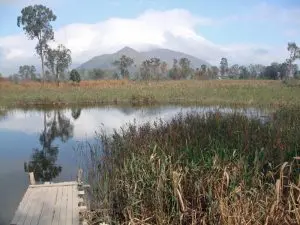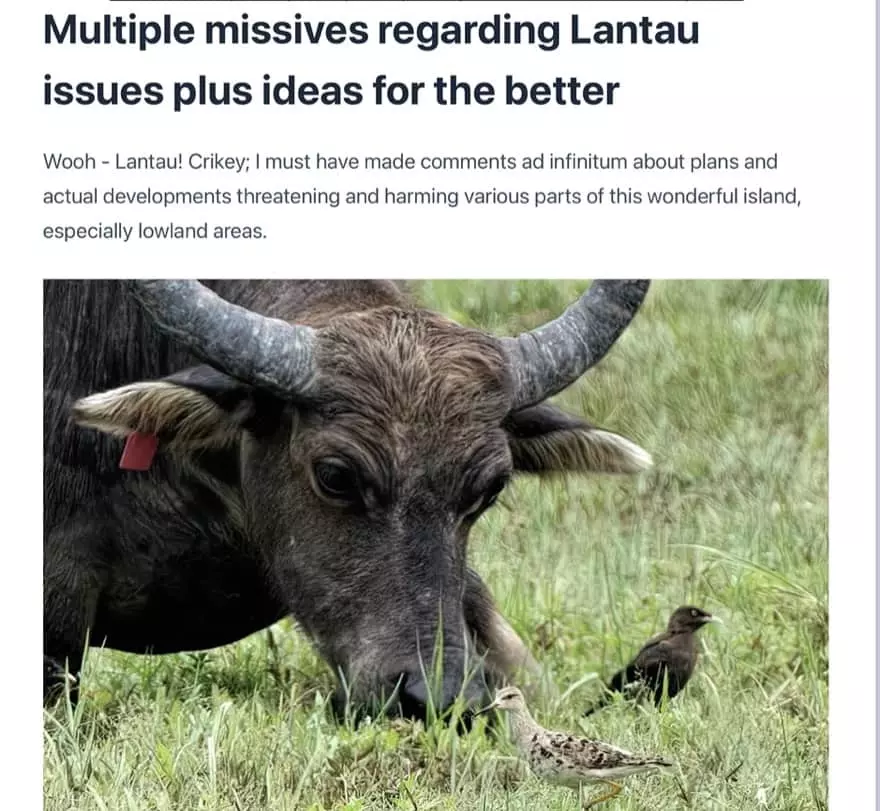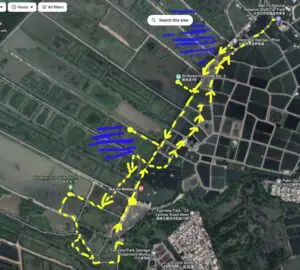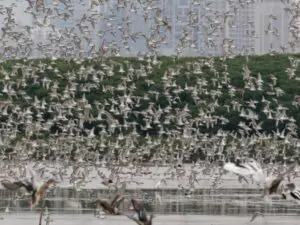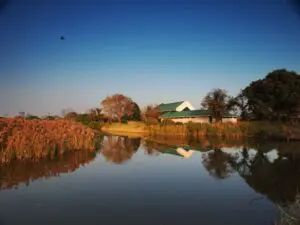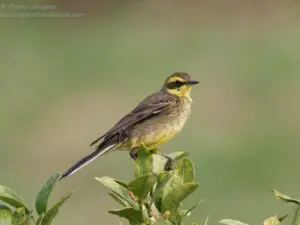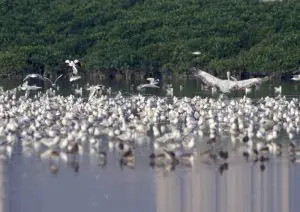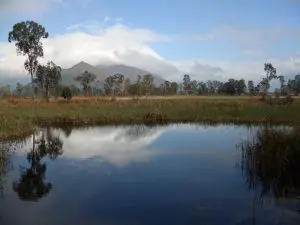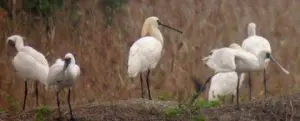If you’re among the privileged few with access to the inner sanctum of Deep Bay in northwest Hong Kong – a viewing hide at the seaward edge of the mangroves, you can experience one of the finest bird spectacles in east Asia.

As the tide rises on a winter’s day, thousands of waterbirds gather on the dwindling area of exposed mudflats. There are flocks of sandpipers and other shorebirds, including eye-catching, black-and-white avocets that weave amongst egrets, herons and spoonbills. Gulls crowd the shoreline; beyond them parties of ducks throng the shallows. The air rings with the birds’ piping and trilling, then cries of alarm and a sudden rush of wingbeats as a peregrine falcon hurtles into their midst, scattering the flocks and leaving the flats briefly empty.
Even if you don’t have a special permit to visit this hide, you can still enjoy the birdlife in Mai Po Marshes reserve and fish pond areas. The flocks are smaller, maybe tens of birds at best, but you could enjoy up-close, eyeball-to-eyeball encounters with species like grey herons, little egrets, common teal – dainty ducks, the drakes with splashes of green on their ruddy-brown heads, and black-winged stilts, named for their remarkably long red legs.

Move slowly, and you might watch these birds feeding, preening, even dozing, as if they are safe from harm. But any abrupt movements, and they’ll swiftly fly off: a reminder that their lives are full of peril, with humans their greatest danger. In Hong Kong, birds are not hunted, yet still face many issues including destruction of the very places they call home, whether on a year-round basis, or during seasons when migrants visit, perhaps for long-term stays.
Internationally important wetland
The mudflats, mangroves and fish ponds are within a wetland complex encompassing Deep Bay, which is actually shallow – it makes a deep indentation on the coast, and is shared by Hong Kong and Shenzhen. The Deep Bay wetland is internationally important for wildlife, particularly tens of thousands of birds that occur each year, including global rarities found only in east Asia.
Worldwide, areas of tidal flats like Deep Bay have long been subject to transformations by humans, especially to create new land for agriculture, aquaculture and settlements. A recent study estimated that 16 percent of the world’s tidal flats were lost between 1984 and 2016, with changes especially pronounced in east Asia. An assessment of the Pearl River delta found that in the past half century, the length of the natural coastline plummeted from 136.91 km to 15.17 km, as reclamations covered some 282 square kilometres – equivalent to around a quarter of Hong Kong’s land area.
Perhaps it’s a wonder Deep Bay has survived at all. It surely helped that the border of the New Territories bisected the bay, leaving the south shore as part of Hong Kong’s rural hinterland. Development pressures have intensified since the 1970s, and while parts of Deep Bay have received protection – notably at Mai Po Marshes, conservation measures have often lacked ambition, even verged on timidity. Now, the government plans to destroy a substantial area of fish ponds to construct part of the San Tin Technopole, and while new protected areas are promised, other potential developments loom – making this year perhaps pivotal in the history of Deep Bay.

Extensive reclamation and early conservation efforts
Reportedly, about half of the bay was covered by dwarf mangroves and salt marshes in 1957, yet the 1950s also saw the beginning of extensive reclamation of these areas. Raised embankments known as bunds were built, to create areas where slat-tolerant rice was grown, ducks and poultry were reared, fish ponds, and gei wai – ponds that could be filled at high tide, and emptied at low tide to harvest shrimp. By 1969, the gei wai and fish ponds covered almost half of the total area.
Many waterbirds took a liking to the new ponds, particularly the gei wai at Mai Po, leading to a visit by renowned British conservationist Peter Scott, who had established the Wildfowl Trust in 1946 and in 1961 was a key founder of WWF. Scott recommended the establishment of a reserve at Mai Po, an idea echoed by the Government’s Provisional Council for the Use and Conservation of the Countryside in 1968.
“Local conservationists were astonished by a newspaper report on 16 March 1975 that the government had given its basic approval to the Canadian Overseas Development Company (CODC) to develop 116 ha of fish-farming land at Tai Shang Wai [adjoining Mai Po] into a large housing estate for about 30,000 people,” noted David Lai, reviewing the controversy around the project in Geography and the Environment in Southeast Asia.

Looking back on this case in 1990, then conservation director of WWF Hong Kong David Melville remarked, “this was the period when the rot set in – there has been a lot of new development since then.” Yet it also prompted a push for protection; as Melville related, “Two members of the Hong Kong Bird Watching Society, Mike Webster and Fred Hechtel, petitioned the government to get some sort of conservation measures. Without their action, we may have lost Mai Po, which was declared a site of special scientific interest. This increases the awareness of planners that a place is important.”
The housing project went ahead, becoming the upscale suburb of Fairview Park, and in the process destroyed Hong Kong’s last nesting site for pheasant-tailed jacana, a handsome lily-trotter. Also, in 1982, the government approved a request from the newly established WWF-Hong Kong to develop a nature reserve at Mai Po. Two years later, the reserve was officially established, and the following year WWF-Hong Kong began work on the Mai Po Marshes Wildlife Education Centre and Nature Reserve.
Mai Po, and star bird species
“Mai Po” has since become almost synonymous with the Deep Bay wetland. Changes in the early years included a boardwalk through the adjacent mangroves to the mudflats, where a hide enabled unprecedented views of birds in the heart of the bay. Helped by this plus a new lagoon created by combining two gei wai, bird observations increased, with regular sightings of global rarities such as spoon-billed sandpiper making Mai Po renowned among birdwatchers worldwide.
The sandpiper is a “birdwatchers’ bird” – pale brown above, white below, barely larger than a sparrow, distinguished for being the only shorebird with a flattened tip to its bill. Soon, however, there was a star bird with more widespread appeal, also with a spoon-shaped bill.
Black-faced spoonbills had been seen regularly in winters since the 1950s, and even though restricted to east Asia they were almost taken for granted until hotshot birdwatcher Peter Kennerly noticed a dearth of information on them, and sent out requests for sightings. In 1990, he published the best total he could calculate for the entire world population: 288. Suddenly, black-faced spoonbill had the dubious distinction of being classed as critically endangered, breeding in northeast Asia, and with only three key winter sites: one in each of Taiwan and Vietnam, and Deep Bay.

Standing around 75cm tall and resembling a stout white egret, though with a spatulate bill, the spoonbill became a flagship species, featuring in media articles about Deep Bay and Mai Po.
Inner Deep Bay listed as a Ramsar Site
Largely as the bay supported significant numbers of the black-faced spoonbill and other migratory waterbirds, it qualified for listing as a wetland of international importance under the UN Ramsar Convention. After years of lobbying by Melville and others, the government agreed to apply for listing, and in 1995 Inner Deep Bay became a Ramsar Site, initially through the UK government, and through the China government from 1997 onwards.
To safeguard the Ramsar Site, and aim for the “wise use” of wetland called for in the convention, the Hong Kong government established zones ranging from the mudflats in the core, to a buffer zone dominated by fish ponds, with regulations restricting the types of developments permitted.
Wetland Park with way more dry land than worthwhile wetland

By then, it was too late to save around 5 square kilometres of fish ponds and farmland near Yuen Long. This had been bought by the impressively named, now defunct Mightycity Company Limited, which in the 1980s began covering the area with sand and rubble, for construction of the Tin Shui Wai new town. By accident, pools and grassland on the reclaimed area attracted a variety of birds, and in 1998 the government decided to build a wetland park to mitigate for their loss.
With the year 2000 approaching, the wetland park morphed into one of the government’s Millennium Projects, involving the Tourism Commission along with the Agriculture, Fisheries and Conservation Department. By the time it opened in 2006, around HK$500 million had been spent on facilities including an expansive visitor centre featuring a walk-in Arctic diorama complete with caribou specimen, an exhibit with Indian crocodiles swimming amidst life-size replicas of mangrove trees, and a 3D theatre with moving seats. (Happily, work is underway on greatly improved indoor exhibits, with more relevance to Hong Kong.)
Outside, water was pumped down an artificial cascade to an almost sterile freshwater area; and at the far end of the park there was a tidal lagoon that became the only good place for birds, yet occupied less than 10 percent of the park’s area [2.8 hectares; of around 45 hectares overall] and paled in comparison with Mai Po and many fish ponds.

The rot continues
Meanwhile, “the rot” was continuing. Deep Bay itself changed as mangroves spread, and the mudflat level rose, with more silt arriving when the Shenzhen River was straightened to alleviate flooding risk; the overall result was a reduced area of tidal flats where birds could feed. Village housing, scrapyards, vehicle repair yards, lorry parks, and former fields with containers stacked six high fringed the fish ponds, many of which fell into disuse given business challenges and uncertainties regarding the future.
These uncertainties stemmed partly from developers large and small buying areas of fish ponds, with notions of profitable ventures. In the early 1990s, Henderson Land planned to build Sunnyville, a housing estate with a golf course on land near Mai Po. WWF Hong Kong was initially supportive, especially as the developer planned to create a nature reserve by restoring an area of fish ponds to mangroves and marshes, but later joined an alliance opposing the scheme – given increased recognition that fish ponds are important for wildlife, plus the government better enforcing regulations that protect them.
Court cases ensued, and Sunnyville eventually reached the High Court before being halted. It seems Henderson set a precedent, however, as similar plans were announced for other fish pond areas, likewise with promises to compensate for destroying some fish ponds by landscaping and managing others nearby so they would attract more wildlife. Conservationists were sceptical of such benefits, and the grander plans were stalled.

One of the grander plans – at Fung Lok Wai fishponds, involving a partnership between WWF Hong Kong and Cheung Kong – was only brought to a halt after WWF Hong Kong left the partnership in 2013, and Green Sense sought a judicial review the following year, leading to the Town Planning Board having to reconsider the application six years later.

Yet this did not mean Fung Lok Wai was safe from harm. In March 2022, the Town Planning Board won an appeal against the judicial review, and the next month an idea for developing it entirely, for housing covering an area larger than Tin Shui Wai, was raised in a board meeting. In response, representatives from the Planning Department, Civil Engineering and Drainage and Department and Housing Department said the proposal was not in line with the planning intention of the area, which is zoned as “Comprehensive Development and Wetland Enhancement Area”.
Over on the north side of the bay, there were few such concerns about conservation after Shenzhen was established in 1979. A NASA satellite image taken in 1988 shows extensive ponds and marshes; just eight years later these had gone, making way for new urban areas and reclamations ready for construction that continues today (images here). Little but a belt of mangroves remains, afforded some protection in the Guangdong Futian Mangrove Nature Reserve.
An avian oasis rises, and falls
As Deep Bay was transformed, the wetland birdlife changed too. Hearteningly, numbers of of black-faced spoonbills surged, with 527 recorded during the 2022/23 winter. Yet this rise was due to factors well beyond Deep Bay, as the world population rapidly increased to over 6900 (early 2024 figure) after Peter Kennerly’s wake-up call had prompted conservation efforts from its breeding grounds in west Korea to multiple migration stopovers and winter haunts.
The situations of other species are mixed, and while overall numbers fluctuate from year to year, the total number of waterbirds recorded in winter rose to a high of over 90,000 in early 2008 but has since fallen back to below 55,000. These tallies prompted researchers to publish a paper in September 2023 with the title “Rise and fall of an avian oasis: Tracking the impacts of land use change in a key coastal wetland in the world’s largest megalopolis”, citing pollution and reclamation as key reasons for the declines of birds such as ducks and gulls.
Big monies for human infrastructure, not wildlife habitats

November 2023 saw the opening of the WWF Jockey Club Mai Po Peter Scott Visitor Centre, a building as grand as its name, rather resembling a city museum though with little to see inside, and with visitor numbers tightly restricted. This was built with a Jockey Club donation of around HK$347 for infrastructure including the visitor centre construction, upgrading footpaths and building two new viewing hides.

While humans benefit from the donation, it did not cover the infrastructure for Mai Po’s wildlife, such as the ponds and their embankments that can likewise require revamps. Asked why, the Jockey Club, WWF Hong Kong and Peter Cornthwaite – CEO of WWF Hong Kong as the infrastructure work was planned – declined to comment.
More visitors could benefit Mai Po and overall Deep Bay conservation
Even when not landscaping ponds, day-to-day management of the habitats can be costly, and the reserve team struggles to get adequate monies, despite annual financial support from the government topped up by fund-raising events like the Big Bird Race. One obvious way to generate more income would be allowing in more visitors.
Worldwide, wetland reserves tend to welcome visitors, with fees helping support ongoing habitat improvements. Mai Po is perhaps an outlier among them, with a restrictive permit system and the Wetland Park supposedly more for the masses. This makes it perhaps somewhat ironic that Peter Scott is commemorated in the visitor centre’s name, for he was a strong advocate of bringing wildlife and people together; last year, the reserve he founded at Slimbridge in the UK attracted some 245,000 visitors, while the slightly larger Mai Po receives around 30,000 visitors per year, half of them schoolchildren.
Plus, having more visitors can boost support for conservation measures. Consider, say, the public outcry as work began on a private project at Ham Tin on the Sai Kung Peninsula, which is very popular with hikers. A dedicated Facebook group attracted 46,000 members in just four days, and the publicity led to government interventions, putting an end to the project. In Deep Bay, by contrast, potential issues are typically contested by just a handful of green groups.

Technopole project threatens San Tin fish ponds
The latest threat alarming green groups involves plans for siting part of the San Tin Technopole, within the Northern Metropolis, on land that is currently fish ponds. “The massive pond filling-in and change of land uses will inevitably result in the loss of wetland area and its ecological function,” predicts WWF Hong Kong in a submission to the government. “Data show that the San Tin fishponds are important foraging, roosting and breeding habitats for waterbirds and the extremely rare Eurasian otter.”

The plans for San Tin would seem to conflict with Town Planning Board guidelines, according to which, “New development within the wetland conservation area would not be allowed unless it is an essential infrastructural project with overriding public interest.” The Planning Department failed to respond to an enquiry regarding the overriding reasons for part of the Technopole being built on the fish ponds area.

New wetland parks may be created … slowwwlllyyyyy
Much like the stalled developers’ proposals, the Technopole plans call for enhancing nearby fish ponds, within a wetland conservation park [adding: I suspect that as and when these plans go ahead, they could encourage developers to dust off and push harder with various plans they have come up with over the years]. Yet with no details forthcoming, green groups are sceptical whether this can really mitigate for the loss of ponds; especially as the park may not be finalised till 2039, which Yu Yat-tung, director of the Hong Kong Birdwatching Society, describes as “not acceptable”.

According to Simon Chan Kin-fung, Assistant Director (Conservation) of the Agriculture, Fisheries and Conservation Department, two more wetland conservation parks are planned, but will be based on experience with the first of the trio. Such caution apparently overlooks the wealth of expertise in managing wetland reserves in Hong Kong and worldwide, and the fact the wetland parks are almost ready made, with scope for enhancements akin to Mai Po’s ongoing evolution.

Fish ponds can mitigate flood risks
As San Tin is on the Shenzhen River floodplain, the Technopole buildings here will require defences against rainstorms, and in November last year a Civil Engineering and Development Department project manager revealed plans for underground facilities with a capacity of 200,000 cubic metres. Leung also said fish ponds could not control floods properly, which is at odds with some other government information – and the results of floodplain restoration work in places such as Germany and California, which has significantly reduced flooding along with enhancing climate change adaptation.
Likewise, in an opinion piece on fishponds in the vicinity of the Technopole (Wetlands are key to securing a climate-resilient Northern Metropolis), three biodiversity experts wrote, “These wetlands have the highly beneficial effect of increasing the climate resilience of Hong Kong, but this function has been largely ignored.”
Government’s 2021 plan for expansive wetland protection
Suppose there could be less construction at San Tin, leaving room for protecting a wetland area 50 percent larger than currently planned; what might the result be? “The remaining fish ponds … can be developed as the Sam Po Shue Wetland Conservation Park covering an area of about 520 hectares,” with enhanced biodiversity and protection of birds’ flight paths. Rather than being a green group’s pipe dream, this proposal is in the Northern Metropolis Development Strategy published by the government in October 2021.

According to this strategy, the wetland conservation parks would have multiple functions including flood prevention. A rough calculation for the Sham Po Shue, based on the water level being able to rise by a metre across half the area, suggests it could accept more than ten times the capacity of the proposed underground facilities, which should benefit flood-prone Shenzhen on the other side of the river.
Ramsar sites are not intended to be sacrosanct, no go zones for people, and the strategy also anticipates the wetland conservation parks including aquaculture, and public education and recreational facilities. It estimates the total area of the entire system of wetlands and coastal ecological conservation can be about 2,000 hectares, adding, “The entire system can serve as a precious ecological habitat with outdoor recreational resources collectively owned and cherished by all Hong Kong citizens.”
Written for the South China Morning Post magazine; published on 19 May 2024 as “How Hong Kong’s Mai Po wetlands are under threat again, and past battles the ‘bird paradise’ has faced“
Suppose you were ageing and with various ailments, yet still attractive to many; and you were in the care of someone who is doing nothing…
After I posted in a birding whatsapp group about issues with the Long Valley Nature Park, I was surprised at a response, sent to the…
If you’re unfamiliar with the Deep Bay wetland shared by Hong Kong and Shenzhen, you might wonder about the significance of the expanse of fish…
Here’s a film I made about Mai Po, using footage James Reynolds and I shot for the reserve, in English, Cantonese and Mandarin versions: Mai…
Yes, this is may seem impossible, ridiculous; but continuing with current state of affairs doesn’t look good for long term future of Deep Bay wetlands.…
Last decade, the future looked bright for the Deep Bay wetland, in northwest Hong Kong. [I wrote this for the South China Morning Post in late…
The WWF Hong Kong managed Mai Po Marshes Nature Reserve has undergone an infrastructure upgrade, with a HK$347 million grant from the Hong Kong Jockey…
With the apartment blocks of Yuen Long and Tin Shui Wai to the southwest, Fairview Park estate to the south, and the urban sprawl of…
There is a Mai Po upgrade project underway [spring 2023], funded by a HK$347.86 million grant from the Hong Kong Jockey Club Charities Trust. This seems…
A “battle of the ponds” is underway in Hong Kong’s northwest corner. It focuses on Deep Bay, a wetlands area that borders on China, near…
“If you look at satellite photos of the Pearl River delta, Deep Bay really shows up. There is nothing else like it.” David Melville Published…
Though Mai Po Marshes is at the heart of Hong Kong’s internationally important Deep Bay wetland, there are other important sites in the area –…
Mai Po is a key component of the internationally important Deep Bay wetland, which straddles the border between northwest Hong Kong and Shenzhen.
Deep Bay in northwest Hong Kong is a wetland of international importance, a magnet for migratory waterbirds.
Mai Po Marshes has become one of the world’s greatest wetland reserves – and a place I’ve come to know well over the years. Indeed,…
Nam Sang Wai is part of the Deep Bay wetland.
At Mai Po Marshes Nature Reserve you can enjoy impressive wildlife spectacles.
Hong Kong Wetland Park is a curious place – with little wetland, excess dryland and an outsize visitor centre with exhibition areas like scifi scenes.…
Despite all the brouhaha, there is no H5N1 at Mai Po.
Mai Po Marshes Nature Reserve is a key part of the internationally important Deep Bay wetland

